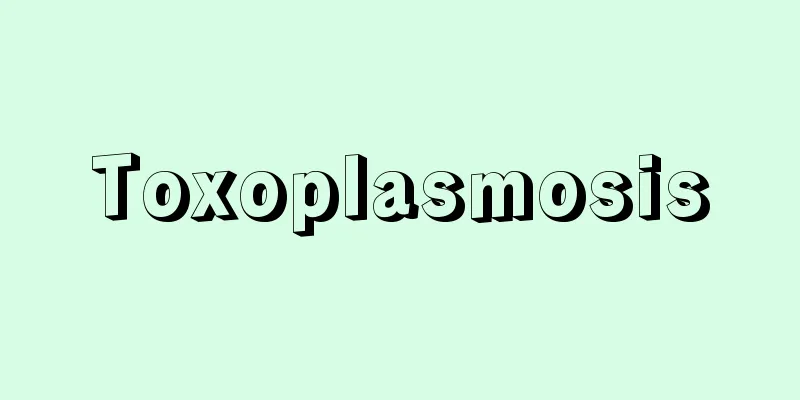Toxoplasmosis

|
Definition: An infectious disease caused by Toxoplasma gondii. Like the malaria parasite and Cryptosporidium, it belongs to the Apicomplexa phylum. Cause and pathogenesis Toxoplasma reproduces sexually and asexually. Felidae are the definitive hosts, in which it reproduces sexually. In other animals, including humans, Toxoplasma only reproduces asexually. In intermediate hosts, it takes two forms: tachyzoites and bradyzoites, and the former are the cause of toxoplasmosis. Tachyzoites divide and grow within the host cell, destroy the cell, and are released to invade new cells. Tachyzoites differentiate and encyst into bradyzoites in muscles and the central nervous system, forming cysts. The trophozoite (Fig. 4-15-5A) is approximately 4-7 μm long and has an apical complex at the anterior end, which is characteristic of sporozoans. The cyst (Fig. 4-15-5B) is usually several tens of μm in diameter and contains many bradyzoites. Infection of definitive hosts occurs through the oral ingestion of slowly growing worms in the body of mice and other animals. When worms first infect a cat, they invade the mucosal epithelial cells of the small intestine, and after several stages of differentiation called merogony and gametogony, they are fertilized and form oocysts (Figure 4-15-5C). The oocysts are excreted in the cat's feces, where they mature in the outside world and form infective sporozoites. Humans are often infected by orally ingesting cysts in meat such as pigs, goats, and sheep. Oocysts in cat feces can also be a source of infection. Congenital infection, which produces the most severe outcomes in humans, only occurs when the primary infection occurs during pregnancy, and is caused by the transplacental transfer of tachyzoites to the fetus. Epidemiology: Infection is widespread in warm-blooded animals, including birds, rodents, and livestock. In Japan, 10-15% of adults have antibodies. The infection rate is higher in Africa and Europe. In general, infection rates are high in areas where people prefer to eat raw sheep, beef, and pork. Based on genotype, it is broadly divided into three groups (Types I to III), which differ in host range, geographic distribution, and pathogenicity in humans and animals. Pathology and pathogenesis The majority of infected individuals with normal immune function are asymptomatic carriers. In cases of immunodeficiency, such as AIDS, malignant lymphoma, leukemia, and organ transplants, disseminated systemic infection from intracellular cysts can occur, and encephalitis can also occur. In other words, this disease is an opportunistic infection. In the acute phase, tachyzoites are found in all organs throughout the body, including muscles, liver, spleen, lymph nodes, and the central nervous system, including the heart. At the site of infection, inflammation is observed around the degenerated worms, and small granulomas are formed in epithelioid cells (Figure 4-15-6). Humoral immunity is insufficient to control infection, and the coordinated action of cytokines such as IL-2, IL-12, and IFN-γ, as well as CD8 + Helper T cell-dependent cellular immunity is important. Clinical symptoms The four main symptoms of congenital toxoplasmosis are retinochoroiditis, hydrocephalus or microcephalus, intracranial calcification, and psycho-motor disorder. In addition, liver enlargement, anemia, jaundice, and lymphadenopathy may occur. In the case of congenital toxoplasmosis, the risk of infection and the severity of the disease vary depending on the stage of pregnancy. In cases of maternal infection during early pregnancy, the risk of infection is low, but most infections result in miscarriage. On the other hand, in cases of infection during the later stages of pregnancy, the possibility of infection of the fetus is high, and although the apparent severity of the disease at birth is low, symptoms often appear later. The main symptoms are necrosis and nodular formation in the central nervous system, pathological reflexes due to perivascular necrosis, spastic limb paralysis, and increased cerebrospinal fluid pressure. The most common form of acquired infection is lymphadenitis in the neck and axilla, which often resolves spontaneously. In cases of immunodeficiency such as AIDS, systemic infections such as hepatitis, pneumonia, and myocarditis occur in addition to multifocal necrotizing encephalitis. Diagnosis and Differential DiagnosisDetection of the protozoa in blood or lymph nodes is not usually performed because the detection rate is low. Immunodiagnosis is used for acute and subacute lesions. Kits for latex agglutination, indirect fluorescent antibody technique, and ELISA are available. The Sabin-Feldman dye test is highly specific, but cannot be performed in general laboratories because it uses live parasites. Paired sera (before and after pregnancy) are required to diagnose maternal infection. If the test is negative before pregnancy and turns positive during pregnancy, the fetus may have congenital toxoplasmosis. In many cases of congenital toxoplasmosis, which is a chronic condition, antibody titers are low, especially in the case of retinochoroiditis, making the test less reliable. It is necessary to differentiate between encephalitis, lymphadenitis, and retinochoroiditis caused by viral infections including EB virus, cytomegalovirus, and HIV, bacterial infections such as tuberculosis and syphilis, and fungal infections. Treatment: In cases of lymphadenitis, sulfa drugs (such as sulfonamides) and pyrimethamine, which have a synergistic effect, are usually administered. Sulfa drugs and pyrimethamine are teratogenic and should not be administered to pregnant women. Pregnant women suspected of having congenital infection or who have eye symptoms are administered acetylspiramycin. Although it is less effective than sulfa drugs and pyrimethamine, it is said to reduce congenital infection and the onset of the disease. Prevention: Eat meat that has been thoroughly cooked and avoid contact with cats (especially kittens) that may be infected. Pregnant women who are not infected should be careful. [Nozaki Tomoyoshi] Toxoplasma Figure 4-15-5 Source : Internal Medicine, 10th Edition About Internal Medicine, 10th Edition Information |
|
定義 トキソプラズマ(Toxoplasma gondii)による感染症である.マラリア原虫・クリプトスポリジウムと同様にアピコンプレクサ門に属する. 原因・病因 トキソプラズマは有性・無性生殖を行う.ネコ科の動物が終宿主であり,そのなかで有性生殖を行う.ヒトを含めたその他の動物のなかでは,トキソプラズマは無性生殖のみを行う.中間宿主のなかでは急増虫体(tachyzoite)と緩増虫体(bradyzoite)の2つの形をとり,前者がトキソプラズマ症の病因となる.急増虫体は宿主細胞内で分裂・増殖し,細胞を破壊して放出され新しい細胞に侵入する.急増虫体は筋肉や中枢神経系などで緩増虫体(bradyzoite)に分化・被囊化し,囊子(シスト,cyst)を形成する.栄養型(図4-15-5A)は長さ約4~7 μm,前端には胞子虫特有のapical complexをもつ.囊子(図4-15-5B)は通常径数十 μm に達し,内部には多数の緩増虫体を含む.終宿主への感染はネズミなどの体内の緩増虫体の経口摂取により起こる.ネコにはじめて感染した虫体は小腸の粘膜上皮細胞に侵入し,メロゴニー(merogony),ガメトゴニー(gametogony)とよばれる数段階の分化の後受精し,オーシストを形成する(図4-15-5C).オーシストはネコの糞便内に排出され,外界で成熟し,感染能力をもつスポロゾイト(sporozoite)が形成される.ヒトへの感染は,ブタ・ヤギ・ヒツジなど食肉中の囊子の経口摂取によることが多い.ネコ糞便中のオーシストも感染源となる.ヒトで最も重篤な結果を生む先天性感染は妊娠中に初感染した場合にのみ起こり,経胎盤的に急増虫体が胎児に移行することで起こる. 疫学 感染は鳥類・齧歯類・家畜を含めた温血動物に広くみられる.わが国では成人の10~15%が抗体を保持している.アフリカやヨーロッパなどでは感染率はより高い.一般に好んで羊・牛・豚肉などの生食をする地域で感染率が高い.遺伝子型別から大きく3つの群(タイプⅠ〜Ⅲ)に分けられ,ヒト・動物における宿主域,地域分布,病原性が異なる. 病理・病態 免疫機能が正常な感染者の大多数は無症状キャリアである.AIDS,悪性リンパ腫,白血病,臓器移植時など免疫不全を伴う際に,組織内囊子からの播種性の全身感染が起きたり,脳炎などがみられる.すなわち本症は日和見感染症(opportunistic infection)の1つである.急性期には急増虫体は心臓を含めた全身の筋肉・肝臓・脾・リンパ節・中枢神経系を含めた全身の臓器にみられる.感染局所では変性した虫体周囲の炎症,類上皮細胞の小肉芽腫形成を認める(図4-15-6).感染制御には液性免疫は不十分で,IL-2,IL-12,IFN-γなどサイトカインの協調作用とともに,CD8+ ヘルパーT細胞依存的な細胞性免疫が重要である. 臨床症状 先天性トキソプラズマ症の4主徴は網脈絡膜炎(retinochoroiditis),水頭症(hydrocephalus),または小頭症(microcephalus),脳内石灰化(intracranial calcification),精神・運動障害(psycho-motor disorder)である.さらに肝腫大,貧血,黄疸,リンパ節腫脹を呈する.先天性トキソプラズマ症の場合,妊娠の時期により胎児の感染リスクおよび重症度は異なる.妊娠初期の母体感染の場合,胎児の感染リスクは低いが,感染した場合の多くは流産の帰結をたどる.一方妊娠後期に感染した場合,胎児の感染の可能性は高く,出産時の見かけの重症度は低いものの,その後症状を示すことが多い.主症状は,中枢神経系の壊死・結節形成,血管周囲壊死による病的反射,痙攣性の四肢麻痺,髄液圧の亢進である.後天感染で最も多い病型は頸部・腋窩などのリンパ節炎で,自然治癒することが多い.AIDSなどの免疫不全の場合は,多巣性壊死性脳炎(multifocal necrotizing encephlitis)とともに肝炎・肺炎・心筋炎などの全身感染を伴う. 診断・鑑別診断 血液中やリンパ節からの原虫の検出は検出率が低く通常行われない.急性,亜急性病変には免疫診断を用いる.ラテックス凝集反応や間接蛍光抗体法,ELISAなどがキット化されている.また,色素試験(Sabin-Feldman’s dye test)は特異性が高いが生虫体を使用するため一般検査室では実施できない.母体の感染の診断には,ペア血清(妊娠時・前と妊娠後)が必要である.妊娠前には陰性であり,妊娠中に陽転した場合には胎児が先天性トキソプラズマ症となる可能性がある.慢性病態である先天性トキソプラズマ症の多く,特に網脈絡膜炎の場合は抗体価も低く信頼度は下がる.EBウイルス,サイトメガロウイルス,HIVを含めたウイルス感染,結核・梅毒など細菌感染,真菌感染による脳炎・リンパ節炎・網脈絡膜炎との鑑別が必要である. 治療 通常リンパ節炎のときは相助作用をもつサルファ剤(スルフォナマイドなど)とピリメタミンを投与する.サルファ剤,ピリメサミンは催奇形性をもつため妊婦に投与してはならない.先天感染を疑った妊婦あるいは眼症状のある場合はアセチルスピラマイシンを投与する.効果はサルファ剤とピリメタミンに劣るが,先天感染と発症を軽減するとされている. 予防 獣肉はよく加熱調理されたものを摂取し,感染の可能性のあるネコ(特に子猫)との接触を避ける.未感染の妊婦は注意が必要である.[野崎智義] トキソプラズマ"> 図4-15-5 出典 内科学 第10版内科学 第10版について 情報 |
Recommend
《Chemistry Outline》 - kagaku yoko
…He also studied the diffusion of liquids, named ...
Nagachika Kanamori
A military commander in the Azuchi-Momoyama perio...
Nanzhao - Nansho
A kingdom formed in the mid-8th century in the Yu...
Naniwabushi - Naniwabushi
Also called Rokyoku, it is a storytelling art wit...
Wu-bi (English spelling)
An ancient Chinese settlement for self-defense, su...
Hapten
A part of an antigen or a low molecular weight su...
Leuchs, JM
…The same could be said about commercial theory, ...
Gigue - Gigue (English spelling) French
A fast and lively dance in 6/8 or 12/8 that was p...
Pinanga dicksonii (English spelling)
…[Sumihiko Hatsushima]. … *Some of the terminolog...
Yoshiyoshi - Gijo
A Chinese-born Buddhist monk who translated Buddh...
ELDO
Abbreviation for European Launcher Development Org...
Idiom Neutral - idiom neutraru
…The movement was quite active for about ten year...
Hydrophobic sol (English spelling)
...Hydrosols use water as a dispersion medium, wh...
Djeser (English spelling)
The second king of the Third Dynasty of Ancient Eg...
Yuwen Tai
He was the powerful man of the Western Wei dynast...
![Nichinan [city] - Nichinan](/upload/images/67cc6e3c0532d.webp)








